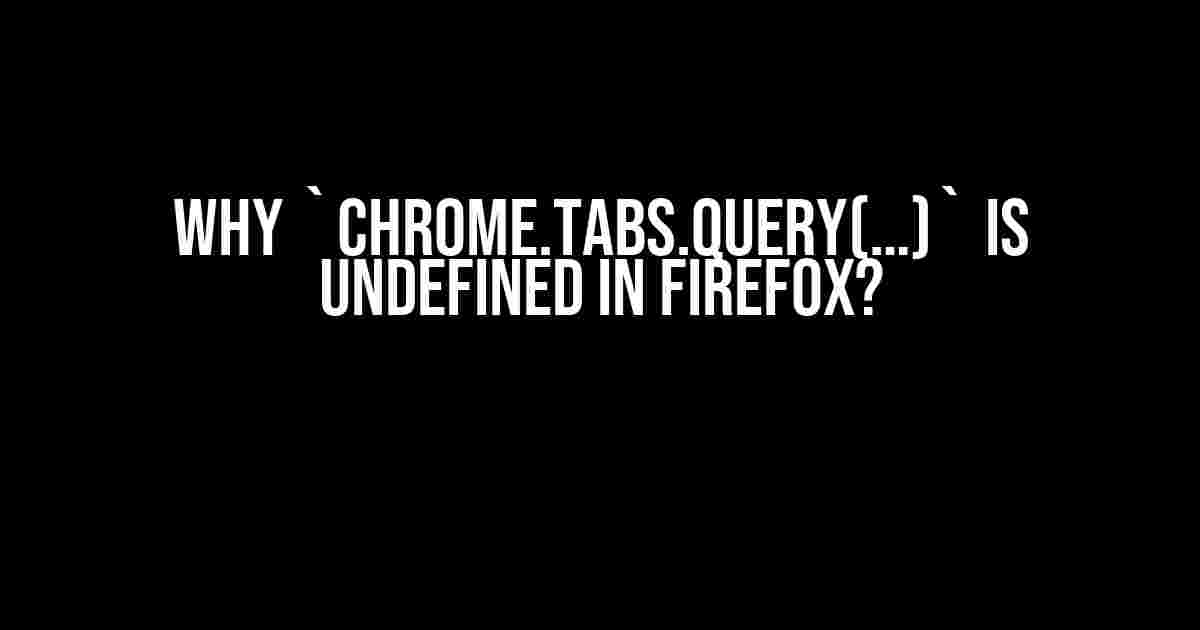Are you a browser extension developer frustrated by the inconsistent behavior of the `chrome.tabs.query()` method? Specifically, have you wondered why it works flawlessly in Google Chrome but returns `undefined` in Mozilla Firefox? Well, buckle up, friend, because we’re about to dive into the world of browser extensions and explore the reasons behind this perplexing issue!
The Origin of the Problem
The `chrome.tabs.query()` method is part of the Chrome Extension API, which allows developers to interact with browser tabs. However, the issue arises when trying to use this method in Firefox, which has its own set of APIs and conventions. The primary reason for the `undefined` return value is due to the fundamental differences in the architecture and extension models of these two browsers.
Chrome’s Extension Model
In Chrome, extensions are built using the Chrome Extension API, which provides a rich set of features for interacting with the browser. The `chrome` namespace is the core of this API, and it’s where you’ll find methods like `chrome.tabs.query()` that allow you to query and manipulate tabs.
chrome.tabs.query({ active: true, currentWindow: true }, function(tabs) {
console.log(tabs);
});This code snippet demonstrates how to use `chrome.tabs.query()` to retrieve an array of active tabs in the current window.
Firefox’s Extension Model
In Firefox, extensions are built using the WebExtensions API, which is designed to be compatible with the Chrome Extension API. However, there are some key differences. Firefox uses the `browser` namespace instead of `chrome`, and the API methods have been adapted to follow Mozilla’s naming conventions.
browser.tabs.query({ active: true, currentWindow: true }, function(tabs) {
console.log(tabs);
});Note the switch from `chrome` to `browser` in the Firefox implementation.
The Solution: Using the Browser-Polyfill
To overcome the `undefined` issue, you can use a browser-polyfill that emulates the Chrome Extension API in Firefox. This polyfill allows you to use the familiar `chrome` namespace and API methods, while still supporting Firefox.
One popular polyfill is the WebExt Chrome Polyfill, which provides a drop-in replacement for the Chrome Extension API. To use it, simply include the polyfill in your extension’s manifest file:
{
"manifest_version": 2,
"name": "My Extension",
"version": "1.0",
"content_scripts": [
{
"matches": ["<all_urls>"],
"js": ["chrome-polyfill.js", "contentScript.js"]
}
]
}In your content script, you can now use the `chrome.tabs.query()` method without worrying about browser compatibility:
chrome.tabs.query({ active: true, currentWindow: true }, function(tabs) {
console.log(tabs);
});Best Practices for Cross-Browser Compatibility
While the browser-polyfill provides a convenient solution, it’s essential to follow best practices for ensuring cross-browser compatibility in your extension:
- Use the browser namespace: When developing for Firefox, use the `browser` namespace to avoid conflicts with the Chrome Extension API.
- Test in multiple browsers: Verify your extension’s functionality in both Chrome and Firefox to catch any browser-specific issues.
- Use feature detection: Instead of relying on browser-specific APIs, use feature detection to determine the capabilities of the browser and adapt your code accordingly.
- Keep your code modular: Organize your code into modules that can be easily switched or replaced depending on the browser environment.
Conclusion
In conclusion, the `chrome.tabs.query()` method returns `undefined` in Firefox because of the fundamental differences in the extension models of Chrome and Firefox. By using a browser-polyfill and following best practices for cross-browser compatibility, you can ensure your extension works seamlessly across both browsers. Remember to stay flexible and adapt to the nuances of each browser, and you’ll be well on your way to creating a robust and reliable browser extension!
| Browser | Namespace | API Method |
|---|---|---|
| Google Chrome | `chrome` | `chrome.tabs.query()` |
| Mozilla Firefox | `browser` | `browser.tabs.query()` |
Now, go forth and conquer the world of browser extensions with confidence!
Frequently Asked Question
If you’re a web developer who’s been scratching your head over why Chrome APIs aren’t working in Firefox, you’re not alone! Here are some answers to frequently asked questions about why `chrome.tabs.query(…)` is undefined in Firefox:
Why is `chrome.tabs.query(…)` undefined in Firefox?
The reason `chrome.tabs.query(…)` is undefined in Firefox is because it’s a Chrome-specific API. Firefox uses a different API, `browser.tabs.query()`, which is part of the WebExtensions API. Chrome and Firefox have different browser architectures, so their APIs aren’t interchangeable.
Can I use `chrome.tabs.query(…)` in Firefox by injecting a polyfill?
Unfortunately, no. Polyfills can’t help you inject Chrome-specific APIs into Firefox. The reason is that Chrome’s APIs are tightly coupled with its browser architecture, which is fundamentally different from Firefox. You need to use the WebExtensions API specifically designed for Firefox.
How do I convert my Chrome extension to work in Firefox?
To convert your Chrome extension, you’ll need to rewrite it using the WebExtensions API, which is supported by both Chrome and Firefox. This means replacing Chrome-specific APIs with their WebExtensions counterparts. You can start by checking the Mozilla documentation for WebExtensions.
Will my extension work in other browsers like Edge or Opera?
Yes! Since the WebExtensions API is supported by multiple browsers, including Edge and Opera, your extension should work across these browsers with minimal modifications. This is one of the benefits of using the WebExtensions API – it provides a more unified experience across browsers.
What’s the best way to test my extension in different browsers?
The best way to test your extension is to use the browser’s built-in extension development tools. For example, Firefox has the “about:debugging” page, while Chrome has the Chrome Extension Development Tool. You can also use online services like BrowserStack or CrossBrowserTesting to test your extension in different browsers.
